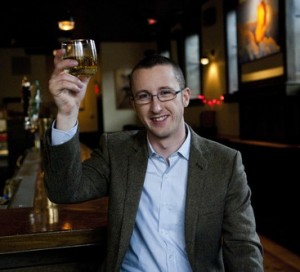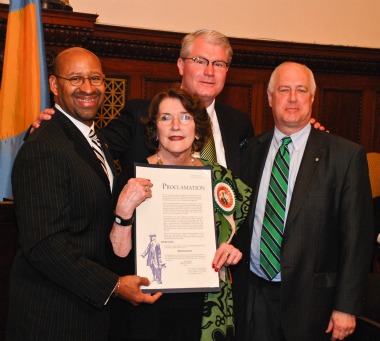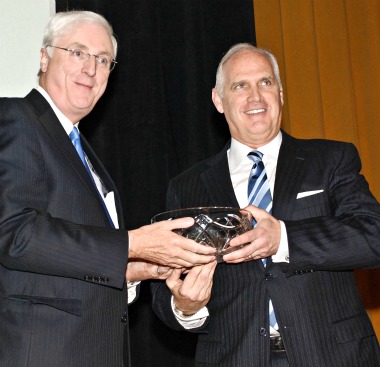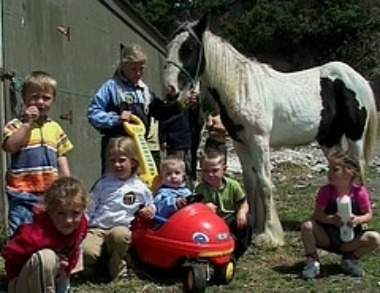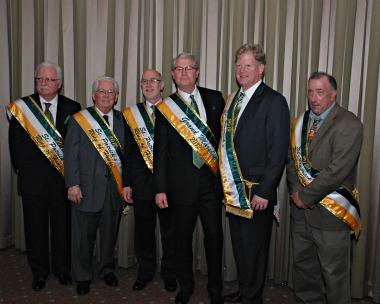
The Ring, from left, Joseph Kelley, Thomas O'Leary, Gerry Timlin, Grand Marshal John Dougherty Jr., Tom Higgins, and Bill Watson.
By Kathy McGee Burns
It is my privilege and pleasure as the President of the St. Patrick’s Day Observance Association to choose a Ring of Honor. This is a select group of Irish/Irish Americans who have contributed to the continuance and preservation of Irish traditions. I am very proud to introduce you to them.
“It’s not the honor you take away with you but the heritage you leave behind.” – Branch Rickey
Thomas Higgins was born in Philadelphia to Irish-born parents: Tommy Higgins (Mountbellew, Co.Galway) and Peggy Kelly (Termon, Co.Donegal). When he was 10, his family moved back to Galway to raise their family of three sons, Tom, Sean and Mickey, back at the old homestead. Tom was a great athlete, excelling in soccer, basketball and Gaelic football. He often came back to Philadelphia to play football in the North America League. He also played for the Mayo, Donegal and Galway teams. winning championships for all.
After attending college at Holy Rosary (Mountbellew) and the University College of Cork where he earned a B.A. in Liberal Arts, he moved back to Philadelphia
to attend St. Joseph’s University and complete his education in accounting. He is now a realtor.
Tom, who is 6’3, red headed, freckled, and very handsome, still has the youthful look of an athlete. He is now the coach of Gaelic football team, Philadelphia Youth. He has dedicated his life to being a player, manager, and a coach.
I asked him why and he readily said, “Heritage. With the lack of Irish Immigration the sport needs life blood and American youth had to start playing it. Now every team has 2/3’s Irish descent and the rest just plain ordinary kids.”
Tom has three sons who practice what he preaches: Tommy,17, Connor, 15, and Ronan,12, are all Gaelic players. He has been married for 18 years to Dee (McAllister) and they also have a sweet, feisty 8-year-old daughter named Ciara.
Tom wins this honor for his preservation of Gaelic football.
“Among all men on earth, bards have a share of honor and reverence because the muse has taught them songs.” – Homer
Well known musician and pub owner, Gerry Timlin, was born in Coalisland, Co. Tyrone, to Joseph and Susan Timlin. His father was the town barber and carpenter. His father, he said, believed that one always needed two occupations, “just in case.” There were five other Timlin siblings: Seamus, Malachy, Niall, Shane and Eileen.
Gerry first gig was playing the coronet (at age 10) in the local marching band. At his first talent contest (age 14) his brother, Shane, lent him his guitar and after winning, Gerry said, “Holy Smokes, there are people who liked me.” He had caught the bug.
In the 50’s and 60’s there was a resurgence of Irish folk music which had a great influence on Gerry. So by the tender age of 16, Gerry was touring as soloist with a group called the Jolly Tinkermen and shared the stage with the likes of the Clancy Brothers, Dubliners and Paddy Reilly.
When he came to the United States in the 1970s, Tommy Makem, who was his greatest hero, gave him some advice, “Grab the audience by the throat and make them listen to you, talk them through every song.” Gerry paid attention. He is an enchanting, lovely man with a voice that charms your heart. He’s one-half of Timlin and Kane, a musical duo that’s been together for more than 30 years.
His restaurant, The Shanachie, in Ambler, is the fulfillment of a 30-year dream. Sadly, though, just last week Gerry and his partner announced that they had sold The Shanachie, though it’s unlikely that this is the end of Gerry’s career as a publican. He’s already looking to the future.
And he’ll never give up entertaining. “Bringing Irish traditions through music, song and story is very gratifying. When I do a show it is one of the greatest feelings to have an audience along with you knowing they’ll be back for more.”
Gerry is married to Lois and has two daughters, Sherri and Susan. Gerry wins this honor for his years of serving up Irish music—and some good food.
“You make a living by what you get. You make a life by what you give.” Anonymous
Thomas J. O’Leary Jr., was born in Philadelphia, to Thomas and Elizabeth Whalen O’Leary. He was raised in the Westbrook Park section of Upper Darby attending Holy Cross Grammar School, Msgr. Bonner, St. Joseph’s University and the American Academy McAllisters Institute of Funeral Services. The family owns O’Leary’s Funeral Home.
Tommy, as he is affectionately known, has spent a lifetime giving, unselfishly, to many causes. He not only gives monetarily but physically and emotion
ally. There are not many ad books, sports teams, or good causes that do not have the O’Leary name attached to them in some way.
In the ‘80s, Tom and his wife, Carol, were involved with Project Children, an organization founded to provide much needed respites in the United States for children from Northern Ireland. Although they had 6 children of their own– Megan, Kathleen, Elizabeth, Margaret, Thomas, and Colleen–
Tom and his wife opened their home to many of these children to give them a break from the grim politics and violence surrounding them.
His dear friend, Parade chaplain Father Kevin Gallagher, said “Tommy O’Leary is a wonderful man who has served, faithfully and selflessly, the Irish community for five decades. His assistance to families at a most difficult period of their life has helped them cope.”
Tom loves his Irish heritage and especially the people for their happy-go-lucky, friendly ways. His own family has roots in Cork. Tom is a member of the Friendly Sons, AOH #4, and Knights of Columbus. Tommy wins this honor for his dedication to the Irish Community.
“It is with great pleasure that I accept this very generous honor on behalf of the Brehon Society, my dad, and all of the labor leaders, John Dougherty included, who have devoted their lives to the betterment of the American worker.” – JosephT. Kelly Jr.
That was the eloquent response from Joseph T. Kelley, Jr. Esq. when he accepted the invitation to be part of the 2012 Ring of Honor, so appropriate this year because the parade grand marshal is a union leader and the parade theme honors the American worker. “Labor” is in his blood.
Joe Kelley was raised in East Germantown, in Immaculate Conception Parish, by Helen (nee Murphy) and Joseph Kelley, Sr. His father was president of Local 113, IUE, International Union of Electrical Workers and president of the Philadelphia CIO.
Joe attended Villanova University and without knowing what career path he wanted to take, opted to go to Villanova Law School. However, the die had been cast for Joe from the beginning; because as his Dad had spent his life in labor relations, he would end up spending a large part of his legal life practicing union labor law.
Joe Kelley is President of the Brehon Law Society, which was founded in 1976 in order to foster the profession of law among individuals of Irish ancestry. This year under Joe’s tutelage and along with his co-chairs, JohnO’Malley, Esq. and Kevin Kent, Esq., an Irish solicitor, they successfully launched the U.S./Ireland Legal Symposium in Westport, Co.Mayo. This conference tackled critical legal issues faced by United States and Irish companies when conducting business at home and abroad. The keynote speaker was the Taoiseach, Enda Kenny. In October 2012, Philadelphia will be hosting the 2nd Symposium.
Joe Kelley is married to Donna and they have two sons, Joseph the 3rd and Austin, and 2 grandchildren, Sophia and Joseph the 4th called Leo. The Kelley and Murphy Family have roots in Co. Mayo.
Joe wins this honor for building bridges between our home and our homeland.
“How come the bosses had silence on their lips as 57 Navvies were buried in a pit, no stone to mark their resting place, no one to mourn their passing.” Wally Page, “Duffy’s Cut”
There is a saying that beneath every mile of railroad track, there’s a dead Irishman. Well, in the case of Mile 59, the Duffy’s Cut of legend, there are actually 55 men and 2 women.
William E. Watson, PhD, head of the History Department at Immaculata University in Malvern, has made sure that the Irish workers from Duffy’s Cut will be mourned, buried and their resting spot memorialized by a beautiful 10-foot Celtic cross.
In 1832, 57 Irish laborers stepped off a ship, the John Stamp, which had come into the Philadelphia port. According to the ship’s log, they were from Donegal, Derry and Tyrone. They were hired by Philip Duffy to build a section of track, near Malvern, for the Philadelphia and Columbia Railroad. Within 6 weeks they were all dead, mostly murdered…brutally. A small number of them had died from cholera but the rest were hunted down, some shot in the head, others beaten with shovel, but most buried in a common grave. Why? They were expendable; there was a strong prejudice against the Irish Catholics and there was a widely held belief that they would spread cholera.
Bill Watson was left paperwork from his grandfather who was secretary to four different presidents of the railroad that led him and his twin brother, Frank, to look for the last burial grounds of these ill-fated immigrants. He saw the injustice. “It’s like an echo through time. They weren’t meant to die there,” he said.
So began the long journey: targeting the exact spot, beginning the dig, fighting the bigotry, getting local cooperation and raising the money. And then they started to appear: coffin nails, buttons, tools, and at one point when Dr. Watson put his shovel into the ground, up popped a completely intact bowl of a clay pipe which was embossed with the words, “Erin Go Bragh,” or Ireland forever. Then, finally, they found the first bones.
No one in Ireland ever heard from these lost children again, but Bill Watson has made sure that they won’t ever be forgotten. The remains of at least some of them, are to be buried at West Laurel Cemetery in Bala Cynwyd on March 9. Watson and his colleagues can’t remove the other remains which are 30 feet down and too near the existing Amtrak tracks, though he hasn’t given that fight up quite yet. He feels that he was chosen by the spirits of the men from Duffy’s Cut, and he intends to do his best by them.

